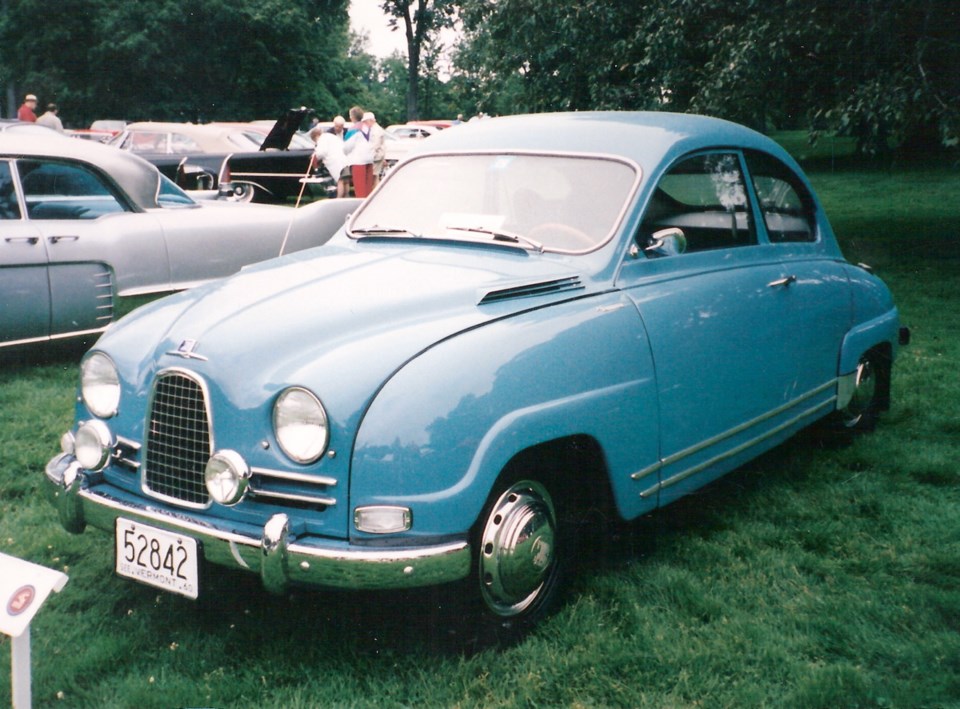Early Saabs were such offbeat cars, they developed a following of devoted owners who valued these eccentricities.
One of Saab’s traditional characteristics was a minimalist approach to engines. It was based on the best engineering tradition of using the most efficient means to an end. For several years, Saabs had only two cylinders when most contemporaries had at least four. It finally relented and switched to three.
The Saab was produced by Swedish airplane company Svenska Aeroplan Aktiebolaget, (acronym Saab), established in Trollhattan (Troll Hill) in 1937. After initially building planes designed by others, it began engineering its own military aircraft.
As the end of the Second World War approached, Saab anticipated a decline in its aircraft business and decided to build a low-cost “people’s car.” Wing designer Gunnar Ljungstrom was placed in charge of the project, so it’s not surprising the Saab’s profile came out resembling an airplane wing.
Ljungstrom had a prototype Saab 92 ready by mid-1946, and it was shown to the press in 1947. The sleek, unit-construction two-door fastback sedan’s aerodynamic drag coefficient was only 0.32, respectable even today. There was no trunk lid, although one would come with the 92B model in 1953.
The prototype’s two-cylinder, 764-cc, two-stroke, plain-bearing 25-horsepower engine was a pre-war DKW unit found in the junkyard and rebuilt. It sent power to the front wheels.
The two-stroke design was chosen to simplify production and reduce tooling costs. The assembly of 92s finally began in 1950, and by March 1954, output had reached 10,000.
Saab continued with two cylinders until 1956, when the three-cylinder, two-stroke, 746-cc, 33-horsepower, roller-bearing Saab 93 appeared. It was mounted longitudinally rather than laterally as the two-cylinder had been, and a water pump replaced the thermosyphon cooling system.
Instead of the 92’s all-independent torsion bar suspension, the 93 got independent coil springs in front and beam axle and coils at the rear. Rack-and-pinion steering continued.
Although still unknown in North America, Saab optimistically put the 93 on display at the 1956 New York International Automobile Show. This publicity, plus some surprising individual and team wins in the Great American Mountain Rally in New England, gave Saab an auspicious start. Saabs would become legendary rally winners, most notably in the hands of intrepid rally driver Erik (On the Roof) Carlsson.
The 10 Saabs shipped over for the show were sold in the northeastern U.S., and American sales reached 1,400 in 1957. Saab was initially concentrated on New England, where its superior front-wheel-drive traction and good handling were highly valued. It gradually moved south and west, and would begin importing cars to Canada in 1975.
The two-stroke engine used crankcase compression for cylinder charging and lacked a traditional oil sump. Lubrication was achieved by adding oil to the fuel, a foreign concept to American motorists. Some Saab engines succumbed to seizure before owners learned to always add a quart of oil with each eight gallons of gasoline.
Saabs had free-wheeling, a one-way clutch that disconnected the engine from the driveline when coasting. This prevented engine seizure on long downhill coasts and allowed clutchless shifting because the engine disconnected when the accelerator was released. The lack of engine compression braking placed an extra load on the brakes.
Road & Track found the 805-kilogram Saab 93’s 27.2-second zero-to 100 km/h acceleration comparable to the popular Volkswagen Beetle’s 28.0. Top speed was a little higher at 120 km/h (VW’s was 113). The Saab’s $1,895 price was about $400 higher.
For those seeking more performance, Saab introduced the 1958 Gran Turismo 750. Its 748-cc engine was increased from 38 to 50 horsepower, giving zero to 100 km/h in just 15.2 seconds and top speed of 142 km/h, outstanding performance for a 3/4-litre sedan. R&T called it a “family sports car.”
Three-cylinder Saabs continued with the same basic shape and with continual improvements. A station wagon was added in 1959 with 841 cc, which the sedans got in 1960, (except in the GT 750, until it became the GT 850 in 1962).
A four-speed transmission became available, automatic oil injection eliminated the messy refuelling, a dual braking system arrived and front-hinged doors replaced the rear-hinged “suicide” types.
By the mid-1960s, it became apparent that the era of the two-stroke engine with its rough, “corn popper” idle was ending. It also tended to be dirty, as emissions were getting increased attention.
In 1967, Saab began purchasing German Ford Taunus V-4s. With the phase-out of the two-stroke three-cylinder in 1968, Saab lost its principal idiosyncrasy. But the V-4 was smoother and more pleasant to drive.



